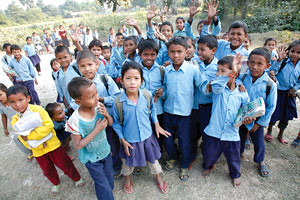
MIN RATNA BAJRACHARYA
For the past six years, administrators in public schools across the country have been celebrating as if it’s Dasain all year through. The government had started the Per Child Fund (PCF) in 2007 which allocates Rs 1,626 for each student to cover the cost of their uniforms, stationery, and other essentials.
However, school administrators have been inflating enrollment rates and fleecing the government. And it’s not only schools that are looting the state, even parents are enrolling their children at more than one school to pocket the scholarship money.
According to the 2011 census, there are 6,003,178 children between the ages of 5 and 13. However, flash reports from the Department of Education (DEO) put the number of students in the 5-13 age bracket at 6,595,565, which leaves almost 600,000 children unaccounted for. In Sunsari alone there were 83,000 ‘fake’ students out of the reported 196, 562 in 2011-12. Sunsari’s District Education Officer Bir, Bahadur Khadka, says that out of the total budget allocated for schools during the last fiscal year, Rs 900,000 has already been collected. Says Khadka, “Falsifying enrollment for more than 80,000 students in one district is no joke. The government needs to intervene immediately before things get completely out of control.”
Schools in Saptari are a step above the rest. They managed to double the number of students in just a single academic year. The flash one report at the beginning of the academic year in 2011 shows the total number of students to be around 84,000 which reached a staggering 149,100 by the end of the year.
There are close to a million ‘fake’ students across 75 districts and more than one billion was spent on them last year alone. The figures for the entire six years exceed Rs 8 billion.
In the last fiscal year, the government allocated Rs 63.9 billion, the highest ever for education of which Rs 51 billion went directly to schools. Of the country’s total education budget, 22 per cent is provided by donor countries and agencies while the rest comes from the state treasury. Since 2009 the World Bank, Asian Development Bank, European Union, DFID, Norway, Finland, Denmark, Australian Aid, UNICEF, and Global Education have been providing funds for the School Sector Reform Plan.
Neither the donors, nor the Ministry of Education (MoE), or even the teachers’ unions have spoken up against such massive embezzlement. Shankar Thapa, vice secretary of the research and information branch of DoE admits to the shortcomings of the monitoring mechanism. “Since it is not possible for the department to cross check the records of each and every school, it’s very difficult for us to find out which students are real and which are not,” acknowledges Thapa.
Although the government issued a directive last June to investigate those involved in the fraud, it first needs to inspect its own staff. Everyone involved in the preparation, monitoring, and sanctioning of funds needs to be held responsible and punished if found guilty and the PCF also needs a major overhaul to weed out the loopholes.
Read the full article in Nepali